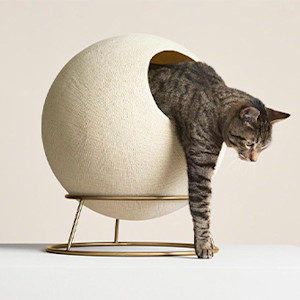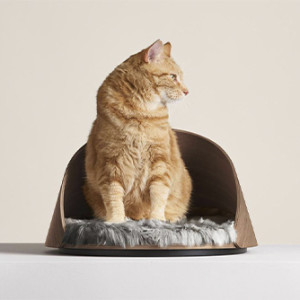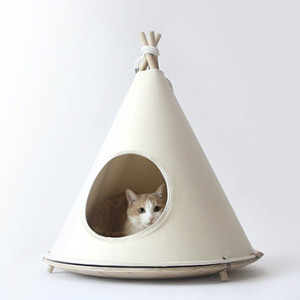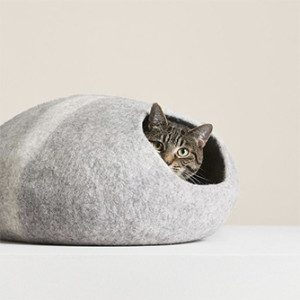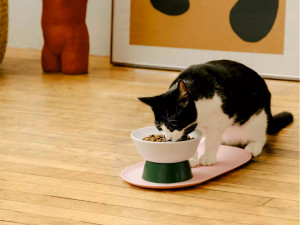Behind the Brand: Tuft+Paw
Chic, sculptural cat furniture inspired by cat behavior and tested at cat cafés.
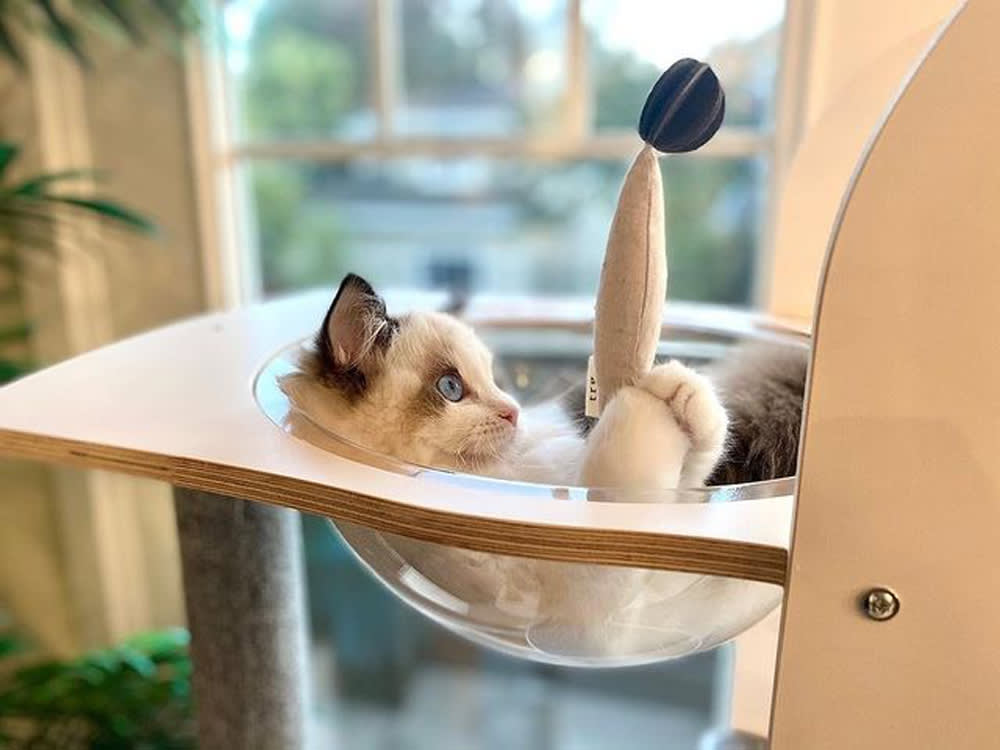
Share Article
Jackson Cunningham is crazy about his cat. The two have a deep connection — so much so that Cunningham confesses he likes to cradle his cat like a baby as they dance together to jazz standards. With a love like that, Cunningham naturally wants only the best for his cat. That’s why he founded tuft + pawopens in a new tab, a brand that produces furniture so chic, sculptural, and Scandi-inspired that it doesn’t look like it was designed for cats — which is kind of the point. Think: cave-like orbs balancing on powder-coated steel bases, modernist floating shelves lined with faux fur, and slatted ash towers that make for airy perches. There’s even a retro record console with a litter box hidden within. Here, Cunningham explains how a cat behaviorist and cat café test subjects inform his design process.
Why did you start tuft + paw?
In 2016, I adopted my cat, Jiggity, from a local rescue organization. When shopping for cat furniture, I quickly realized how limited the options were. Every company seemed focused on making the lowest-cost product possible, which meant minimal design and using the cheapest materials available. Somehow, they weren’t designed for cats or humans — cat needs weren’t met and the furniture was...ugly, something you’d want to hide. It seemed strange to me that cat products were held to such a low standard, despite the love we have for our cats. I knew we could do better.

Save on the litter with color-changing tech that helps you better care for your cat.
You’ve described tuft + paw as a cat-first brand. What does that mean?
As a cat-first company, we’re raising the standards of cat products by focusing on behavioral research, modern design, and quality. We have a few checkpoints in the design process to determine how cats will respond. First, all our designers are briefed with our Guide to Catsopens in a new tab, which is an exhaustive, thorough guide on cat behavior and how it relates to product design that we created with our cat behaviorist. This ensures all our designers are following the same principles and that we’re able to share our learnings across all products. At the later stages of concept iteration, we discuss the product directly with our cat behaviorist to see if they have any red flags.
How do you test the products?
Once a product design passes testing with our cat behaviorist, we test very early material prototypes at local cat cafés to ensure durability of materials. One week at a cat cafe is equivalent to about a year’s worth of “wear and tear” in a one-cat household, so it’s a great way of testing durability. Once we get a final prototype, we leave it at the cat café to observe over a period of weeks to ensure that cats actually use it — and that there aren’t any surprises that we weren’t aware of in the design phase. We have a very active cat person community, so in some cases, we will send out early samples to a small group of cat people to test with their cats in their homes. Our team also takes products home to test with their cats, including my cat, Jiggity.
Jiggity! Such an adorable name. Which products get Jiggity’s stamp of approval?
Jiggity’s favorite product is the Puffopens in a new tab Cat Bed. It took him a while to warm up to it, but now he uses it all the time. I love Jiggity to bits. We have our own rituals: he hangs out with me late at night when my partner has gone to bed and I’m still working. We dance together to Frank Sinatra — I hold him like a baby and I’m convinced he loves “dancing” to jazz. Jiggity has lots of idiosyncrasies: something I learned about cats is how unique each of their personalities are. He can be annoying and needy at times, but he’s also very perceptive to how I’m feeling. And damn, if I don’t love him.
My cat is the center of my world. She is curious and loves to climb trees — which of your products would you recommend for her?
We would recommend the Frondopens in a new tab, our take on the classic cat tree. It features three adjustable tiers of oval perches, meaning you can customize and switch up climbs and areas to perch. Great for active cats who love a switch up. The Frond’s central pillar is entirely wrapped in tightly-secured sisal rope, providing a natural scratching surface at every level. Alternatively, the Zipopens in a new tab is a simpler, very tall scratching post that adventurous cats can perch on top of.
You make more than scratching posts. You have a patent pending on the Cove Litter Boxopens in a new tab. What’s special about it?
The Cove is unique in that it holds all tools — the brush and the scoop — related to the litter box within. The main body of the Cove has also been designed to create a lever that allows humans to easily lift and empty litter (no liner required) as well as a hidden handle on the underside of the litter box. We also listened to early customer feedback to increase the size by 30% and added an optional wall extender add-on for cats who like to dig. We spent 18 months developing this product to create our take on the absolute best litter box, covering cat needs while keeping beautiful, functional design top of mind.
Has demand for your products ramped up given how many people have been adopting pets during the pandemic?
We saw a big boom throughout the pandemic — it’s natural that with spending more time indoors, our customers are interested in investing in products for their pets and home. That said, we’re looking to shift how customers perceive cat furniture as a whole. It’s no longer about getting the cheapest possible product that will check a box on a to-do list. It’s a matter of re-examining how integral cats are to our happiness, therefore providing pieces that are on par with the furniture we buy for our own needs.
See one of Tuft+Paw’s toys in action below.
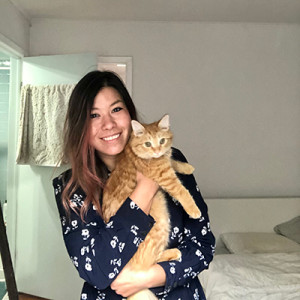
Mai Lynn Miller Nguyen
Mai Lynn Miller Nguyen is a freelance culture writer who launched a neighborhood publication called The Pet Times while in elementary school. She is a devoted (read: obsessed) pet parent to Pippi, a spirited little orange cat who was found in the wilds of Michigan in 2020, has since crossed the country three times, and loves to climb trees.
